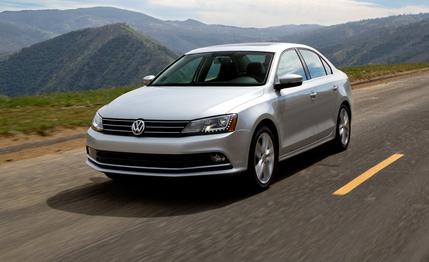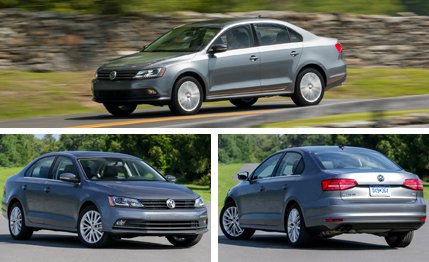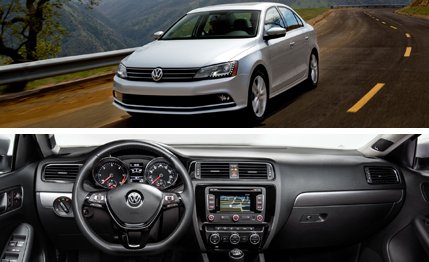
 First Drive Review
First Drive Review
Rowing through the gears of a 2015 Volkswagen Jetta S TDI’s six-speed manual transmission as we roll along the scenic two-laners of Virginia’s horse country, we marvel at the fact that we’re actually having fun. Yeah, fun. In a Jetta.
Never would we have predicted this back when VW first introduced the current Jetta for the 2011 model year. While it boasted increased space, son-of-Audi styling, and a more competitive price, the Jetta was soundly criticized for its utter dearth of character, relentlessly cheap-feeling cabin, gruff five-cylinder base engine, and chassis that had regressed into the Dark Ages with rear drum brakes and a torsion-beam rear suspension.
Since then, VW has made incremental and significant improvements to its North American bread-butterer, and by 2014, all U.S.-market Jettas featured four-wheel disc brakes and an independent rear suspension. Also for 2014, a new EA888 1.8-liter turbocharged base four-cylinder engine forced the cantankerous 2.5-liter five-cylinder into retirement. Enter the 2015 Jetta, with its midcycle update that brings new front and rear styling, upgraded interior materials (including—at last—a soft-touch dash top), and a new EA288 diesel engine in TDI models. Alas, it seems that the Jetta has now become the car Volkswagen should have been building since the beginning.


Typically, the most significant aspects of a vehicle’s midcycle refresh are revised lighting and fascia elements, but in the 2015 Jetta’s case, these are arguably the least interesting of its updates. A new grille emphasizes the car’s width, as does the new rear bumper, while new headlamps offer more widely available LED daytime running lights and the taillamps evoke its Audi-brand cousins. And for the first time, even the least expensive Jetta rides on aluminum wheels. To what extent the revisions improve the Jetta’s looks is up to the observer, but arguably it has become ever harder to tell the difference between the Jetta and the one-size-up Passat.
The interior, once one of the Jetta’s worst attributes, has become a convincingly nice place to spend time for 2015. It’s still Teutonically austere and the door panels are hard plastic, but the dashboard looks far classier, dressed as it is with tunneled gauges and reflective piano-black trim panels. High-end content such as navigation has trickled down from higher trims to low- and mid-grade levels, and interestingly, an available touch-screen infotainment system without navigation is actually larger than that of the navigation-equipped cars. And the seats of the S, SE, and SEL models we drove were firm and supportive.
The first thing we noticed out on the road is the Jetta’s rock-solid structure. Considerable changes were made to the structure, primarily to help the car pass new crash tests, and the results are palpable. Even with the diesel S model’s modest 16-inch wheels, the Jetta has confident handling, tidy body control, and heroically low noise levels. The steering actually communicates a measure of road feel to the driver—not a lot, but some—and is quick and linear in its response. In other words, the Jetta feels German. As it should.
VW did not provide us with one of its new price-leader base 2015 Jettas with the wimpy 115-hp eight-valve naturally aspirated 2.0-liter four-banger, a version probably best left to rental-car fleets. Our time was divided evenly among an SE model (with the silky 1.8-liter EA888 four-cylinder paired with VW’s six-speed automatic transmission) and S and SEL models (both with VW’s fabulous new EA288 diesel, one with the six-speed manual and the other with a six-speed dual-clutch automatic). As we said in our initial review of a 2014 Jetta 1.8, the turbo four-cylinder gas engine is a honey. It’s EPA-rated at 25 mpg in the city and 37 on the highway, regardless of whether you choose the five-speed manual or the six-speed automatic transmission.


The new diesel idles with a creamy smoothness and revs with enthusiasm all the way up to redline with so little attendant noise that we found ourselves checking the tachometer to confirm that we were actually driving the diesel. Producing 150 horsepower from 3500 to 4000 rpm and 236 lb-ft of torque from 1750 to 3000 rpm, it is down just 20 horses on the gas engine but boasts 52 lb-ft more twist. Redesigned in nearly every respect compared with the diesel it replaces, with an intercooler integrated right into the intake manifold, the engine has grunt all over the place and reduces turbo lag to virtual irrelevance, delivering its power with that intensely satisfying shove-in-the-back feeling we love so much with oil-burners. The six-cog manual shifts cleanly and easily, but the available six-speed DSG dual-clutch automatic is a particularly eager partner in play, making self-shifting all but unnecessary in its intuitive Sport mode. The fact that the diesel nets impressive EPA fuel-economy estimates (31 mpg city/45 mpg highway for the DSG; 31/46 with the manual) is very sweet icing on the cake.
Pricewise, the gas-fired versions of the Jetta start at $17,035 for the aforementioned, special-order stripper model, with the 1.8 SE model beginning at $19,815 and rising to $26,200 for a Jetta 1.8 SEL. TDI models start at $22,460 for the TDI S manual and rise to $28,330 for the SEL with the six-speed dual-clutch auto. GLI and Hybrid models will be added early next year as late 2015 models. The real coup for the Jetta remains a couple of years away when it is scheduled to jump onto VW’s excellent MQB platform. But in the meantime, the Jetta has gone from being one of our least favorite compact cars to taking a very close second place in a five-car comparo behind the effervescent, 10Best-winning Mazda 3. Will the 2015 model’s incremental improvement finally give it the chops to unseat the Mazda in the next go-around? We shall see.